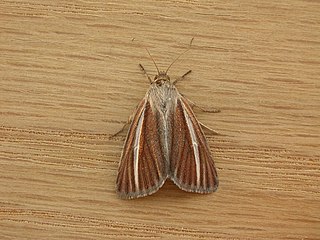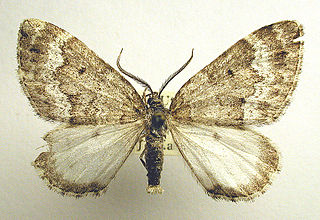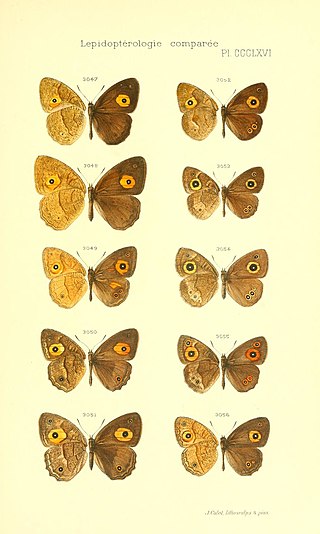Related Research Articles

The Siret or Sireth is a river that rises from the Carpathians in the Northern Bukovina region of Ukraine, and flows southward into Romania before it joins the Danube. It is 647 km (402 mi) long, of which a 559 km (347 mi) section is in Romania, and its basin area is 44,811 km2 (17,302 sq mi), of which 42,890 km2 (16,560 sq mi) in Romania. Its average discharge is 250 m3/s (8,800 cu ft/s). In ancient times, it was named Hierasus.

Angerona is a monotypic moth genus in the family Geometridae erected by Philogène Auguste Joseph Duponchel in 1829. Its only species, Angerona prunaria, the orange moth, was first described by Carl Linnaeus in his 1758 10th edition of Systema Naturae.

Liptena is a genus of butterflies in the family Lycaenidae. Liptena is endemic to the Afrotropics.

Arhopala bazalus, the powdered oakblue, is a lycaenid or blue butterfly first described by William Chapman Hewitson in 1852. It is found in Myanmar, mainland China, India, Indochina, Japan, the Philippines, and Taiwan.

Elophila is a genus of moths of the family Crambidae described by Jacob Hübner in 1822.

Heliocheilus is a genus of moths of the family Noctuidae. Former synonyms include Canthylidia.
Clethrogyna is a genus of tussock moths in the family Erebidae. The genus was described by Rambur in 1866.
Raphipeza is a genus of moths in the family Lasiocampidae. The genus was erected by Arthur Gardiner Butler in 1880.

Zythos is a genus of moths in the family Geometridae. It was described by David Stephen Fletcher in 1979.

Xylophanes is a genus of moths in the family Sphingidae erected by Jacob Hübner in 1819. As of 2000, there are about 96 species and subspecies included in the genus.

Heliocheilus turbata, the spotted straw moth, is a moth in the family Noctuidae. It is found in North America, including Georgia.

Zythos turbata is a moth of the family Geometridae first described by Francis Walker in 1862. It is found in southern Myanmar and on Borneo, Sumatra, Java, Peninsular Malaysia and the Philippines.

Colostygia turbata is a moth of the family Geometridae. It is found from the mountains of Europe to the Altai, as well as the Kamchatka Peninsula and Canada.

Heteropsis turbata is a butterfly in the family Nymphalidae. It is found on Madagascar. The habitat consists of natural grasslands.

Liptena turbata is a butterfly in the family Lycaenidae. It is found in Cameroon, the Republic of the Congo, Gabon and the southern part of the Democratic Republic of the Congo.

Elophila turbata is a moth in the family Crambidae found in Africa and Asia. It was first described by the English entomologist Arthur Gardiner Butler in 1881 from a specimen found in Yokohama, Japan.
Heteresmia is a genus of longhorn beetles of the subfamily Lamiinae, containing the following species:
Heteresmia spissicornis is a species of beetle in the family Cerambycidae. It was described by Johan Christian Fabricius in 1801. It is known from Brazil.

Perineura is a genus of sawflies belonging to the family Tenthredinidae.
Microgaster godzilla is a species of aquatic parasitoid wasp from Japan. Its host is the caterpillar Elophila turbata. The wasp is named after Godzilla.
References
- ↑ BioLib.cz - Heteresmia turbata. Retrieved on 8 September 2014.